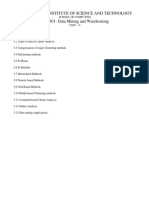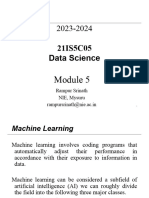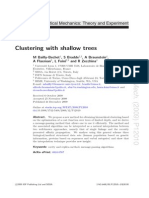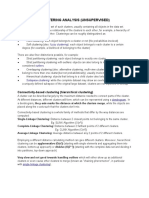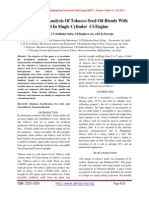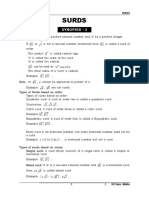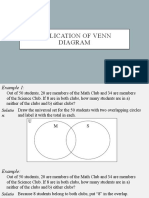0 ratings0% found this document useful (0 votes)
46 viewsEfficient Data Clustering With Link Approach
Data clustering faces lots of
studies and researches and at last the results
being competitive to conventional algorithms,
even though using these techniques finally we
are getting an incomplete information. The
existed partitioned-information matrix contains
particular cluster-data point relations only, with
lot entries which are not recognized. The paper
explores researches that preferres this crisis
decomposes the efficiency of the clustering
result, and it contains a new link-based
approach, which increases the conventional
matrix by revealing the entries which are not
recognized based upon the common things
which are present both clusters and in ensemble.
Often, a perfect link-based algorithm is invented
and used for the underlying common
assessment. After all those, to gain the
maximum clustering outputs, a graph
partitioning technique is used for a weighted
bipartite graph that is formulated from the
refined matrix. Results on various real data sets
suggest that the proposed link-based method
mostly performs both conventional clustering
algorithms for categorical data and also most
common cluster ensemble techniques.
Uploaded by
seventhsensegroupCopyright
© © All Rights Reserved
Available Formats
Download as PDF, TXT or read online on Scribd
0 ratings0% found this document useful (0 votes)
46 viewsEfficient Data Clustering With Link Approach
Data clustering faces lots of
studies and researches and at last the results
being competitive to conventional algorithms,
even though using these techniques finally we
are getting an incomplete information. The
existed partitioned-information matrix contains
particular cluster-data point relations only, with
lot entries which are not recognized. The paper
explores researches that preferres this crisis
decomposes the efficiency of the clustering
result, and it contains a new link-based
approach, which increases the conventional
matrix by revealing the entries which are not
recognized based upon the common things
which are present both clusters and in ensemble.
Often, a perfect link-based algorithm is invented
and used for the underlying common
assessment. After all those, to gain the
maximum clustering outputs, a graph
partitioning technique is used for a weighted
bipartite graph that is formulated from the
refined matrix. Results on various real data sets
suggest that the proposed link-based method
mostly performs both conventional clustering
algorithms for categorical data and also most
common cluster ensemble techniques.
Uploaded by
seventhsensegroupCopyright
© © All Rights Reserved
Available Formats
Download as PDF, TXT or read online on Scribd
You are on page 1/ 8
International Journal of Computer Trends and Technology (IJCTT) volume 4 Issue10 Oct 2013
ISSN: 2231-2803 http://www.ijcttjournal.org Page3648
Efficient Data Clustering with Link Approach
1
Y. Sireesha,
2
CH. Srinivas,
3
K.C. Ravi Kumar.
1
PG Scholar, Department of Computer Science and Engineering,
Sridevi Womens Engineering College
Hyderabad, A.P, India
2
Associate Professor, Department of Computer Science and Engineering,
Sridevi Womens Engineering College
Hyderabad, A.P, India
3
Head of the Department, Department of Computer Science and Engineering,
Sridevi Womens Engineering College
Hyderabad, A.P, India
Abstract: Data clustering faces lots of
studies and researches and at last the results
being competitive to conventional algorithms,
even though using these techniques finally we
are getting an incomplete information. The
existed partitioned-information matrix contains
particular cluster-data point relations only, with
lot entries which are not recognized. The paper
explores researches that preferres this crisis
decomposes the efficiency of the clustering
result, and it contains a new link-based
approach, which increases the conventional
matrix by revealing the entries which are not
recognized based upon the common things
which are present both clusters and in ensemble.
Often, a perfect link-based algorithm is invented
and used for the underlying common
assessment. After all those, to gain the
maximum clustering outputs, a graph
partitioning technique is used for a weighted
bipartite graph that is formulated from the
refined matrix. Results on various real data sets
suggest that the proposed link-based method
mostly performs both conventional clustering
algorithms for categorical data and also most
common cluster ensemble techniques.
I. INTRODUCTION
To examine the data set we have different
approaches through get down to its structure data
clustering is the efficient way. Because of the
beneficial characteristics of clustering like
mining, machine learning and pattern recognition.
Clustering deals with the data to get stick with
similar ones. Those similar ones will get into
group or cluster. There are sort of algorithms for
clustering like k-means and PAM which are used
for clustering the numerical data, these are used to
International Journal of Computer Trends and Technology (IJCTT) volume 4 Issue10 Oct 2013
ISSN: 2231-2803 http://www.ijcttjournal.org Page3649
get the distance between feature vectors. The
drawback is this not get inherited directly for
clustering purpose on the categorical data,
where domain values are discrete and have no
ordering defined. As a result, many categorical
data clustering algorithms have been introduced
in recent years, with applications to interesting
domains such as protein interaction data. The
initial method was developed by making use of
Gowers similarity coefficient. Following that,
the k-modes algorithm in extended the
conventional k-means with a simple matching
dissimilarity measure and a frequency-based
method to update centroids.
Fig 1. The basic process of cluster ensembles.
As a single-pass algorithm, Squeezer makes use
of a prespecified similarity threshold to
determine which of the existing clusters to
which a data point under examination is
assigned. LIMBO is a hierarchical clustering
algorithm that uses the Information Bottleneck
(IB) framework to define a distance measure for
categorical tuples. The concepts of evolutionary
computing and genetic algorithm have also been
adopted by a partitioning method for categorical
data, i.e., GAClust. Cobweb is a model-based
method primarily exploited for categorical data
sets. Different graph models have also been
investigated by the STIRR, ROCK, and CLICK
techniques. In addition, several density-based
algorithms have also been devised for such
purpose, for instance, CACTUS, COOLCAT, and
CLOPE. Although, a large number of algorithms
have been introduced for clustering categorical
data, the No Free Lunch theorem suggests1 there
is no single clustering algorithm that performs
best for all data sets and can discover all types of
cluster shapes and structures presented in data.
Each algorithm has its own strengths and
weaknesses. For a particular data set, different
algorithms, or even the same algorithm with
different parameters, usually provide distinct
solutions. Therefore, it is difficult for users to
decide which algorithm would be the proper
alternative for a given set of data. Recently,
cluster ensembles have emerged as an effective
solution that is able to overcome these limitations,
and improve the robustness as well as the quality
of clustering results. The main objective of cluster
ensembles is to combine different clustering
decisions in such a way as to achieve accuracy
superior to that of any individual clustering.
Examples of well-known ensemble methods are:
1. The feature-based approach that transforms the
problem of cluster ensembles to clustering
categorical data.
International Journal of Computer Trends and Technology (IJCTT) volume 4 Issue10 Oct 2013
ISSN: 2231-2803 http://www.ijcttjournal.org Page3650
2. The direct approach that finds the final
partition through relabeling the base clustering
results.
3. graph-based algorithms that employ a graph
partitioning methodology, and
4. The pairwise-similarity approach that makes
use of co-occurrence relations between data
points.
Despite notable success, these methods generate
the final data partition based on incomplete
information of a cluster ensemble. The
underlying ensemble-information matrix
presents only cluster-data point relationships
while completely ignores those among clusters.
As a result, the performance of existing cluster
ensemble techniques may consequently be
degraded as many matrix entries are left
unknown. This paper introduces a link-based
approach to refining the aforementioned matrix,
giving substantially less unknown entries. A
link-based similarity measure is exploited to
estimate unknown values from a link network of
clusters. This research uniquely bridges the gap
between the task of data clustering and that of
link analysis. It also enhances the capability of
ensemble methodology for categorical data,
which has not received much attention in the
literature. In addition to the problem of
clustering categorical data that is investigated
herein, the proposed framework is generic such
that it can also be effectively applied to other data
types.
II. DISCUSSION
The difficulty of categorical data analysis is
characterized by the fact that there is no inherent
distance (or similarity) between attribute values.
The RM matrix that is generated within the LCE
approach allows such measure between values of
the same attribute to be systematically quantified.
The concept of link analysis [34], [35], [36] is
uniquely applied to discover the similarity among
attribute values, which are modeled as vertices in
an undirected graph. In particular, two vertices are
similar if the neighboring contexts in which they
appear are similar. In other words, their similarity
is justified upon values of other attributes with
which they co-occur. While the LCE methodology
is novel for the problem of cluster ensemble, the
concept of defining similarity among attribute
values (especially with the case of direct
ensemble, Type-I) has been analogously adopted
by several categorical data clustering algorithms.
Initially, the problem of defining a context-based
similarity measure has been investigated in [61]
and [62]. In particular, an iterative algorithm,
called Iterated Contextual Distances (ICD), is
introduced to compute the proximity between two
values. Similar to LCE, the underlying distance
metric is based on the occurrence statistics of
attribute values. The WTQ algorithm is
summarized below
International Journal of Computer Trends and Technology (IJCTT) volume 4 Issue10 Oct 2013
ISSN: 2231-2803 http://www.ijcttjournal.org Page3651
However, the fundamental information model
that is used by ICD and LCE to capture the
associations between data points and attribute
values are notably different: a sequential
probabilistic chain and a link network for ICD
and LCE, respectively. Note that LCE makes
use of WTQ that is a single-pass similarity
algorithm, while ICD requires the chain model
to be randomly initialized and iteratively
updated to a fixed point.
III. SYSTEM DEVELOPMENT
The link based approach will be done in
following steps
K-Means with Euclidian Distance (1)
Transform categorical (text) into
numerical value
On Numerical data apply K-Means with
Euclidian distance measure.
The outcome of the 1 is {C11, C12,
C13 .. C1n} where C1 is the cluster 1
with 1 clustering algorithm.
K-Means with cosine similarity (2)
Consider numerical values are categorical
data
On categorical data apply (2) for
clustering.
The outcome of the 2 is {C21, C22,
C23.. C2n}
K-Means with Jaccords Coefficient (3)
Consider numerical values as categorical
data
On categorical data, apply (3) for
clustering
The outcome of the 3 is {C31, C32,
C33, C34 C3n}
Cluster Ensemble
Direct Ensemble
Full Space Ensemble
Subspace Ensemble
Generating Refined Matrix (RM)
Prepare RM as a matrix where each record
of the original dataset D as {x1, x2,
x3 xm}
International Journal of Computer Trends and Technology (IJCTT) volume 4 Issue10 Oct 2013
ISSN: 2231-2803 http://www.ijcttjournal.org Page3652
Weighted Triple Quality (WTQ)
Wxy = Lx Ly
Lx U Ly
Apply WTQ on RM, The output of the module
is refined clusters.
IV. RELATED WORK
Despite pursuing an objective analogous to that
of the LCE approach, several categorical data
clustering methods have been developed using
different mechanisms to specify a distance
between attribute values: STIRR, ROCK, and
CACTUS, for instance. STIRR is an iterative
algorithm based on nonlinear dynamical
systems. A database is encoded into a graph
structure, where each weighted node stands for a
specific attribute value. STIRR iteratively
updates the weight configuration until a stable
point (called basin) is reached. This is achieved
using a user-defined combiner function to
estimate a node weight from those of others that
associate to the same data records. Unlike LCE,
the similarity between any node pair cannot be
explicitly measured here. In fact, STIRR only
divides nodes of each attribute into two groups
(one with large positive weights and the other
with small negative weights) that correspond to
projections of clusters on the attribute. Yet, the
post processing required to generate the actual
clusters is nontrivial and not addressed in the
original work. While LCE is generally robust to
parameter settings, it is hard to analyze the
stability of the STIRR system for any useful
combiner function [63]. Rigorous experimentation
and fine tuning of parameters are needed for the
generation of a meaningful clustering [64]. ROCK
[14] makes use of a link graph, in which nodes
and links represent data points (or tuples) and
their similarity, respectively. Two tuples are
similar if they shared a large number of attribute
values. Note that the link connecting two nodes is
included only when the corresponding similarity
exceeds a user-defined threshold. With tuples
being initially regarded as singleton clusters,
ROCK merges clusters in an agglomerative
hierarchical fashion, while optimizing a cluster
quality that is defined in terms of the number of
links across clusters. Note that the graph models
International Journal of Computer Trends and Technology (IJCTT) volume 4 Issue10 Oct 2013
ISSN: 2231-2803 http://www.ijcttjournal.org Page3653
used by ROCK and LCE are dissimilarthe
graph of data points and that of attribute values
(or clusters), respectively. Since the number of
data points is normally greater than that of
attribute values, ROCK is less efficient than
LCE. As a result, it is unsuitable for large data
sets. Also, the selection of a smooth function
that is used to estimate a cluster quality is a
delicate and difficult task for average users.
CACTUS also relies on the co-occurrence
among attribute values. In essence, two attribute
values are strongly connected if their support
(i.e., the proportion of tuples in which the values
co-occur) exceeds a prespecified value. By
extending this concept to all attributes,
CACTUS searches for the distinguishing sets,
which are attribute value sets that uniquely
occur within only one cluster. These sets
correspond to cluster projections that can be
combined to formulate the final clusters. Unlike
LCE, the underlying problem is not designed
using a graph based concept. It is also
noteworthy that CACTUS and its recent
extension assume each cluster to be identified
by a set of attribute values that occur in no other
cluster. While such conjecture may hold true for
some data sets, it is unnatural and unnecessary
for the clustering process. This rigid constraint
is not implemented by the LCE method. Besides
these approaches, traditional categorical data
analysis also utilizes the market-basket
numerical representation of the nominal data
matrix. This transformed matrix is similar to the
BM, which has been refined to the RM
counterpart by LCE. A similar attempt in
identifies the connection between category
utility of the conceptual clustering (Cobweb) and
the classical objective function of k-means.
Fig 2. An example of a cluster network, where each edge is
marked with its weight.
As a result, the so-called market-basket matrix
used by the former is transformed to a variation
that can be efficiently utilized by the latter. The
intuitions of creating this rescaled matrix and the
RM are fairly similar. However, the methods used
to generate them are totally different. LCE
discovers unknown entries (i.e., 0) in the
original BM from known entries (1), which are
preserved and left unchanged. On the other hand,
the method in maps the attribute-value-specific
1 and 0 entries to the unique standardized
values. Unlike the RM, this matrix does not
International Journal of Computer Trends and Technology (IJCTT) volume 4 Issue10 Oct 2013
ISSN: 2231-2803 http://www.ijcttjournal.org Page3654
conserve the known fact (1 entries), whose
values are now different from one to another
attribute. Despite the fact that many clustering
algorithms and LCE are developed with the
capability of comparing attribute values in
mind, they achieve the desired metric
differently, using specific information models.
LCE uniquely and explicitly models the
underlying problem as the evaluation of link-
based similarity among graph vertices, which
stand for specific attribute values (for Type-I
ensemble) or generated clusters (for Type-II and
Type-III). The resulting system is more efficient
and robust, as compared to other clustering
techniques emphasized thus far. In addition to
SPEC, many other classical clustering
techniques, k-means and PAM among others,
can be directly used to generate the final data
partition from the proposed RM. The LCE
framework is generic such that it can be adopted
for analyzing other types of data.
V. CONCLUSION
This paper presents a novel, highly effective
link-based cluster ensemble approach to
categorical data clustering. It transforms the
original categorical data matrix to an
information-preserving numerical variation
(RM), to which an effective graph partitioning
technique can be directly applied. The problem
of constructing the RM is efficiently resolved by
the similarity among categorical labels (or
clusters), using the Weighted Triple-Quality
similarity algorithm. The empirical study, with
different ensemble types, validity measures, and
data sets, suggests that the proposed link-based
method usually achieves superior clustering
results compared to those of the traditional
categorical data algorithms and benchmark cluster
ensemble techniques. The prominent future work
includes an extensive study regarding the
behavior of other link-based similarity measures
within this problem context. Also, the new
method will be applied to specific domains,
including tourism and medical data sets.
REFERENCES
[1] D.S. Hochbaum and D.B. Shmoys, A Best
Possible Heuristic for the K-Center Problem,
Math. of Operational Research, vol. 10, no. 2, pp.
180-184, 1985.
[2] L. Kaufman and P.J. Rousseeuw, Finding
Groups in Data: An Introduction to Cluster
Analysis. Wiley Publishers, 1990.
[3] A.K. Jain and R.C. Dubes, Algorithms for
Clustering. Prentice-Hall, 1998.
[4] P. Zhang, X. Wang, and P.X. Song,
Clustering Categorical Data Based on Distance
Vectors, The J. Am. Statistical Assoc., vol. 101,
no. 473, pp. 355-367, 2006.
[5] J. Grambeier and A. Rudolph, Techniques of
Cluster Algorithms in Data Mining, Data Mining
and Knowledge Discovery, vol. 6, pp. 303-360,
2002.
International Journal of Computer Trends and Technology (IJCTT) volume 4 Issue10 Oct 2013
ISSN: 2231-2803 http://www.ijcttjournal.org Page3655
[6] K.C. Gowda and E. Diday, Symbolic
Clustering Using a New Dissimilarity Measure,
Pattern Recognition, vol. 24, no. 6, pp. 567-
578, 1991.
[7] J.C. Gower, A General Coefficient of
Similarity and Some of Its Properties,
Biometrics, vol. 27, pp. 857-871, 1971.
[8] Z. Huang, Extensions to the K-Means
Algorithm for Clustering Large Data Sets with
Categorical Values, Data Mining and
Knowledge Discovery, vol. 2, pp. 283-304,
1998.
[9] Z. He, X. Xu, and S. Deng, Squeezer: An
Efficient Algorithm for Clustering Categorical
Data, J. Computer Science and Technology,
vol. 17, no. 5, pp. 611-624, 2002.
[10] P. Andritsos and V. Tzerpos, Information-
Theoretic Software Clustering, IEEE Trans.
Software Eng., vol. 31, no. 2, pp. 150-165, Feb.
2005.
[11] D. Cristofor and D. Simovici, Finding
Median Partitions Using Information-
Theoretical-Based Genetic Algorithms, J.
Universal Computer Science, vol. 8, no. 2, pp.
153-172, 2002.
[12] D.H. Fisher, Knowledge Acquisition via
Incremental Conceptual Clustering, Machine
Learning, vol. 2, pp. 139-172, 1987.
You might also like
- A Fast Clustering Algorithm To Cluster Very Large Categorical Data Sets in Data MiningNo ratings yetA Fast Clustering Algorithm To Cluster Very Large Categorical Data Sets in Data Mining13 pages
- Paper-2 Clustering Algorithms in Data Mining A ReviewNo ratings yetPaper-2 Clustering Algorithms in Data Mining A Review7 pages
- Machine Learning with Clustering: A Visual Guide for Beginners with Examples in PythonFrom EverandMachine Learning with Clustering: A Visual Guide for Beginners with Examples in PythonNo ratings yet
- Cse-Iii-Engineering Mathematics - Iii (15mat31) - Solution PDFNo ratings yetCse-Iii-Engineering Mathematics - Iii (15mat31) - Solution PDF68 pages
- Examples With Assignment On Finite DifferenceNo ratings yetExamples With Assignment On Finite Difference15 pages
- Comparison of Graph Clustering AlgorithmsNo ratings yetComparison of Graph Clustering Algorithms6 pages
- An Enhanced Clustering Algorithm To Analyze Spatial Data: Dr. Mahesh Kumar, Mr. Sachin YadavNo ratings yetAn Enhanced Clustering Algorithm To Analyze Spatial Data: Dr. Mahesh Kumar, Mr. Sachin Yadav3 pages
- Ijcet: International Journal of Computer Engineering & Technology (Ijcet)No ratings yetIjcet: International Journal of Computer Engineering & Technology (Ijcet)5 pages
- Ijcet: International Journal of Computer Engineering & Technology (Ijcet)No ratings yetIjcet: International Journal of Computer Engineering & Technology (Ijcet)11 pages
- 1) A Link Based Cluster Enemble Approach For Categorical Data ClustingNo ratings yet1) A Link Based Cluster Enemble Approach For Categorical Data Clusting6 pages
- Clustering Algorithms On Data Mining in Categorical DatabaseNo ratings yetClustering Algorithms On Data Mining in Categorical Database4 pages
- A Hash-Based Co-Clustering Algorithm For Categorical DataNo ratings yetA Hash-Based Co-Clustering Algorithm For Categorical Data12 pages
- Survey On Cluster Ensemble Approach For Categorical DataNo ratings yetSurvey On Cluster Ensemble Approach For Categorical Data6 pages
- Graph Partitioning Advance Clustering TechniqueNo ratings yetGraph Partitioning Advance Clustering Technique14 pages
- 6 IJAEST Volume No 2 Issue No 2 Representative Based Method of Categorical Data Clustering 152 156No ratings yet6 IJAEST Volume No 2 Issue No 2 Representative Based Method of Categorical Data Clustering 152 1565 pages
- A Relational Graph Based Approach Using Multi-Attribute Closure Measure For Categorical Data ClusteringNo ratings yetA Relational Graph Based Approach Using Multi-Attribute Closure Measure For Categorical Data Clustering5 pages
- 2015 Elsevier Dynamic Clustering With Improved Binary Artificial Bee Colony AlgorithmNo ratings yet2015 Elsevier Dynamic Clustering With Improved Binary Artificial Bee Colony Algorithm12 pages
- SPINEX-Clustering: Similarity-Based Predictions With Explainable Neighbors Exploration For Clustering ProblemsNo ratings yetSPINEX-Clustering: Similarity-Based Predictions With Explainable Neighbors Exploration For Clustering Problems54 pages
- Sine Cosine Based Algorithm For Data ClusteringNo ratings yetSine Cosine Based Algorithm For Data Clustering5 pages
- Sathyabama Institute of Science and Technology SIT1301-Data Mining and WarehousingNo ratings yetSathyabama Institute of Science and Technology SIT1301-Data Mining and Warehousing22 pages
- A New Shared Nearest Neighbor Clustering AlgorithmNo ratings yetA New Shared Nearest Neighbor Clustering Algorithm16 pages
- INCONCO Interpretable Clustering of Numerical andNo ratings yetINCONCO Interpretable Clustering of Numerical and10 pages
- C: A Hierarchical Clustering Algorithm Using Dynamic ModelingNo ratings yetC: A Hierarchical Clustering Algorithm Using Dynamic Modeling22 pages
- Survey of Combined Clustering Approaches: Mr. Santosh D. Rokade, Mr. A. M. BainwadNo ratings yetSurvey of Combined Clustering Approaches: Mr. Santosh D. Rokade, Mr. A. M. Bainwad5 pages
- Author's Accepted Manuscript: Pattern RecognitionNo ratings yetAuthor's Accepted Manuscript: Pattern Recognition41 pages
- An Approach of Hybrid Clustering Technique For Maximizing Similarity of Gene ExpressionNo ratings yetAn Approach of Hybrid Clustering Technique For Maximizing Similarity of Gene Expression14 pages
- IJRET - Scalable and Efficient Cluster-Based Framework For Multidimensional IndexingNo ratings yetIJRET - Scalable and Efficient Cluster-Based Framework For Multidimensional Indexing5 pages
- Implementation of Dbrain Search Algorithm On Page ClusteringNo ratings yetImplementation of Dbrain Search Algorithm On Page Clustering5 pages
- Fast_and_Robust_General_Purpose_Clustering_AlgoritNo ratings yetFast_and_Robust_General_Purpose_Clustering_Algorit29 pages
- 2009 A Survey of Evolutionary Algorithms For ClusteringNo ratings yet2009 A Survey of Evolutionary Algorithms For Clustering23 pages
- Xu, R., & Wunsch, D. (2005) - Survey of Clustering AlgorithmsNo ratings yetXu, R., & Wunsch, D. (2005) - Survey of Clustering Algorithms35 pages
- Clustering Theory Applications and AlgorithmsNo ratings yetClustering Theory Applications and Algorithms9 pages
- Slicing A New Approach To Privacy Preserving Data PublishingNo ratings yetSlicing A New Approach To Privacy Preserving Data Publishing19 pages
- Analysis of Dendrogram Tree For Identifying and Visualizing Trends in Multi-Attribute Transactional DataNo ratings yetAnalysis of Dendrogram Tree For Identifying and Visualizing Trends in Multi-Attribute Transactional Data5 pages
- A Hybrid Approach To Speed-Up The NG20 Data Set Clustering Using K-Means Clustering AlgorithmNo ratings yetA Hybrid Approach To Speed-Up The NG20 Data Set Clustering Using K-Means Clustering Algorithm8 pages
- Path Based Dissimilarity Measured For Thesis Book PreparationNo ratings yetPath Based Dissimilarity Measured For Thesis Book Preparation11 pages
- By Lior Rokach and Oded Maimon: Clustering MethodsNo ratings yetBy Lior Rokach and Oded Maimon: Clustering Methods5 pages
- An Efficient Enhanced K-Means Clustering AlgorithmNo ratings yetAn Efficient Enhanced K-Means Clustering Algorithm8 pages
- Introduction To Data Science Unsupervised Learning: CS 194 Fall 2015 John CannyNo ratings yetIntroduction To Data Science Unsupervised Learning: CS 194 Fall 2015 John Canny54 pages
- A Survey of Clustering Algorithms For An Industrial Context: SciencedirectNo ratings yetA Survey of Clustering Algorithms For An Industrial Context: Sciencedirect12 pages
- Performance Evaluation of Distance Metrics in The Clustering AlgorithmsNo ratings yetPerformance Evaluation of Distance Metrics in The Clustering Algorithms14 pages
- DATA MINING and MACHINE LEARNING. CLASSIFICATION PREDICTIVE TECHNIQUES: SUPPORT VECTOR MACHINE, LOGISTIC REGRESSION, DISCRIMINANT ANALYSIS and DECISION TREES: Examples with MATLABFrom EverandDATA MINING and MACHINE LEARNING. CLASSIFICATION PREDICTIVE TECHNIQUES: SUPPORT VECTOR MACHINE, LOGISTIC REGRESSION, DISCRIMINANT ANALYSIS and DECISION TREES: Examples with MATLABNo ratings yet
- Design, Development and Performance Evaluation of Solar Dryer With Mirror Booster For Red Chilli (Capsicum Annum)No ratings yetDesign, Development and Performance Evaluation of Solar Dryer With Mirror Booster For Red Chilli (Capsicum Annum)7 pages
- Fabrication of High Speed Indication and Automatic Pneumatic Braking System0% (1)Fabrication of High Speed Indication and Automatic Pneumatic Braking System7 pages
- Non-Linear Static Analysis of Multi-Storied Building100% (1)Non-Linear Static Analysis of Multi-Storied Building5 pages
- Implementation of Single Stage Three Level Power Factor Correction AC-DC Converter With Phase Shift ModulationNo ratings yetImplementation of Single Stage Three Level Power Factor Correction AC-DC Converter With Phase Shift Modulation6 pages
- FPGA Based Design and Implementation of Image Edge Detection Using Xilinx System GeneratorNo ratings yetFPGA Based Design and Implementation of Image Edge Detection Using Xilinx System Generator4 pages
- An Efficient and Empirical Model of Distributed ClusteringNo ratings yetAn Efficient and Empirical Model of Distributed Clustering5 pages
- Design and Implementation of Multiple Output Switch Mode Power SupplyNo ratings yetDesign and Implementation of Multiple Output Switch Mode Power Supply6 pages
- Experimental Analysis of Tobacco Seed Oil Blends With Diesel in Single Cylinder Ci-EngineNo ratings yetExperimental Analysis of Tobacco Seed Oil Blends With Diesel in Single Cylinder Ci-Engine5 pages
- Analysis of The Fixed Window Functions in The Fractional Fourier DomainNo ratings yetAnalysis of The Fixed Window Functions in The Fractional Fourier Domain7 pages
- Quick Sort: - It Is An Algorithm of Divide and Conquer50% (2)Quick Sort: - It Is An Algorithm of Divide and Conquer6 pages
- Chapter-2 First Order and First Degree Ordinary Differential EquationsNo ratings yetChapter-2 First Order and First Degree Ordinary Differential Equations7 pages
- Maxima and Minima: Engr. Billy Ray M. Oldan, MseeNo ratings yetMaxima and Minima: Engr. Billy Ray M. Oldan, Msee5 pages
- Suffix Trees: CSC 448 Bioinformatics Algorithms Alexander DekhtyarNo ratings yetSuffix Trees: CSC 448 Bioinformatics Algorithms Alexander Dekhtyar8 pages
- Unit 2 Test Derivatives: Part A: Knowledge and Understanding (20 Marks)No ratings yetUnit 2 Test Derivatives: Part A: Knowledge and Understanding (20 Marks)3 pages
- Counting and Probability Handout 2021 AMC 10 Seminar Final - 2No ratings yetCounting and Probability Handout 2021 AMC 10 Seminar Final - 29 pages
- Advanced Calculus For Applications - Francis B Hilderand 1962No ratings yetAdvanced Calculus For Applications - Francis B Hilderand 1962657 pages
- Experiment 1: Digital Signal Processing LabNo ratings yetExperiment 1: Digital Signal Processing Lab17 pages
- Learning From Labeled and Unlabeled Data On A Directed GraphNo ratings yetLearning From Labeled and Unlabeled Data On A Directed Graph8 pages
- Int Gcse Mathematics A Modular Spec Content MappingNo ratings yetInt Gcse Mathematics A Modular Spec Content Mapping80 pages
- A Fast Clustering Algorithm To Cluster Very Large Categorical Data Sets in Data MiningA Fast Clustering Algorithm To Cluster Very Large Categorical Data Sets in Data Mining
- Paper-2 Clustering Algorithms in Data Mining A ReviewPaper-2 Clustering Algorithms in Data Mining A Review
- Machine Learning with Clustering: A Visual Guide for Beginners with Examples in PythonFrom EverandMachine Learning with Clustering: A Visual Guide for Beginners with Examples in Python
- Cse-Iii-Engineering Mathematics - Iii (15mat31) - Solution PDFCse-Iii-Engineering Mathematics - Iii (15mat31) - Solution PDF
- An Enhanced Clustering Algorithm To Analyze Spatial Data: Dr. Mahesh Kumar, Mr. Sachin YadavAn Enhanced Clustering Algorithm To Analyze Spatial Data: Dr. Mahesh Kumar, Mr. Sachin Yadav
- Ijcet: International Journal of Computer Engineering & Technology (Ijcet)Ijcet: International Journal of Computer Engineering & Technology (Ijcet)
- Ijcet: International Journal of Computer Engineering & Technology (Ijcet)Ijcet: International Journal of Computer Engineering & Technology (Ijcet)
- 1) A Link Based Cluster Enemble Approach For Categorical Data Clusting1) A Link Based Cluster Enemble Approach For Categorical Data Clusting
- Clustering Algorithms On Data Mining in Categorical DatabaseClustering Algorithms On Data Mining in Categorical Database
- A Hash-Based Co-Clustering Algorithm For Categorical DataA Hash-Based Co-Clustering Algorithm For Categorical Data
- Survey On Cluster Ensemble Approach For Categorical DataSurvey On Cluster Ensemble Approach For Categorical Data
- 6 IJAEST Volume No 2 Issue No 2 Representative Based Method of Categorical Data Clustering 152 1566 IJAEST Volume No 2 Issue No 2 Representative Based Method of Categorical Data Clustering 152 156
- A Relational Graph Based Approach Using Multi-Attribute Closure Measure For Categorical Data ClusteringA Relational Graph Based Approach Using Multi-Attribute Closure Measure For Categorical Data Clustering
- 2015 Elsevier Dynamic Clustering With Improved Binary Artificial Bee Colony Algorithm2015 Elsevier Dynamic Clustering With Improved Binary Artificial Bee Colony Algorithm
- SPINEX-Clustering: Similarity-Based Predictions With Explainable Neighbors Exploration For Clustering ProblemsSPINEX-Clustering: Similarity-Based Predictions With Explainable Neighbors Exploration For Clustering Problems
- Sathyabama Institute of Science and Technology SIT1301-Data Mining and WarehousingSathyabama Institute of Science and Technology SIT1301-Data Mining and Warehousing
- A New Shared Nearest Neighbor Clustering AlgorithmA New Shared Nearest Neighbor Clustering Algorithm
- C: A Hierarchical Clustering Algorithm Using Dynamic ModelingC: A Hierarchical Clustering Algorithm Using Dynamic Modeling
- Survey of Combined Clustering Approaches: Mr. Santosh D. Rokade, Mr. A. M. BainwadSurvey of Combined Clustering Approaches: Mr. Santosh D. Rokade, Mr. A. M. Bainwad
- An Approach of Hybrid Clustering Technique For Maximizing Similarity of Gene ExpressionAn Approach of Hybrid Clustering Technique For Maximizing Similarity of Gene Expression
- IJRET - Scalable and Efficient Cluster-Based Framework For Multidimensional IndexingIJRET - Scalable and Efficient Cluster-Based Framework For Multidimensional Indexing
- Implementation of Dbrain Search Algorithm On Page ClusteringImplementation of Dbrain Search Algorithm On Page Clustering
- Fast_and_Robust_General_Purpose_Clustering_AlgoritFast_and_Robust_General_Purpose_Clustering_Algorit
- 2009 A Survey of Evolutionary Algorithms For Clustering2009 A Survey of Evolutionary Algorithms For Clustering
- Xu, R., & Wunsch, D. (2005) - Survey of Clustering AlgorithmsXu, R., & Wunsch, D. (2005) - Survey of Clustering Algorithms
- Slicing A New Approach To Privacy Preserving Data PublishingSlicing A New Approach To Privacy Preserving Data Publishing
- Analysis of Dendrogram Tree For Identifying and Visualizing Trends in Multi-Attribute Transactional DataAnalysis of Dendrogram Tree For Identifying and Visualizing Trends in Multi-Attribute Transactional Data
- A Hybrid Approach To Speed-Up The NG20 Data Set Clustering Using K-Means Clustering AlgorithmA Hybrid Approach To Speed-Up The NG20 Data Set Clustering Using K-Means Clustering Algorithm
- Path Based Dissimilarity Measured For Thesis Book PreparationPath Based Dissimilarity Measured For Thesis Book Preparation
- By Lior Rokach and Oded Maimon: Clustering MethodsBy Lior Rokach and Oded Maimon: Clustering Methods
- An Efficient Enhanced K-Means Clustering AlgorithmAn Efficient Enhanced K-Means Clustering Algorithm
- Introduction To Data Science Unsupervised Learning: CS 194 Fall 2015 John CannyIntroduction To Data Science Unsupervised Learning: CS 194 Fall 2015 John Canny
- A Survey of Clustering Algorithms For An Industrial Context: SciencedirectA Survey of Clustering Algorithms For An Industrial Context: Sciencedirect
- Performance Evaluation of Distance Metrics in The Clustering AlgorithmsPerformance Evaluation of Distance Metrics in The Clustering Algorithms
- DATA MINING and MACHINE LEARNING. CLASSIFICATION PREDICTIVE TECHNIQUES: SUPPORT VECTOR MACHINE, LOGISTIC REGRESSION, DISCRIMINANT ANALYSIS and DECISION TREES: Examples with MATLABFrom EverandDATA MINING and MACHINE LEARNING. CLASSIFICATION PREDICTIVE TECHNIQUES: SUPPORT VECTOR MACHINE, LOGISTIC REGRESSION, DISCRIMINANT ANALYSIS and DECISION TREES: Examples with MATLAB
- Design, Development and Performance Evaluation of Solar Dryer With Mirror Booster For Red Chilli (Capsicum Annum)Design, Development and Performance Evaluation of Solar Dryer With Mirror Booster For Red Chilli (Capsicum Annum)
- Fabrication of High Speed Indication and Automatic Pneumatic Braking SystemFabrication of High Speed Indication and Automatic Pneumatic Braking System
- Non-Linear Static Analysis of Multi-Storied BuildingNon-Linear Static Analysis of Multi-Storied Building
- Implementation of Single Stage Three Level Power Factor Correction AC-DC Converter With Phase Shift ModulationImplementation of Single Stage Three Level Power Factor Correction AC-DC Converter With Phase Shift Modulation
- FPGA Based Design and Implementation of Image Edge Detection Using Xilinx System GeneratorFPGA Based Design and Implementation of Image Edge Detection Using Xilinx System Generator
- An Efficient and Empirical Model of Distributed ClusteringAn Efficient and Empirical Model of Distributed Clustering
- Design and Implementation of Multiple Output Switch Mode Power SupplyDesign and Implementation of Multiple Output Switch Mode Power Supply
- Experimental Analysis of Tobacco Seed Oil Blends With Diesel in Single Cylinder Ci-EngineExperimental Analysis of Tobacco Seed Oil Blends With Diesel in Single Cylinder Ci-Engine
- Analysis of The Fixed Window Functions in The Fractional Fourier DomainAnalysis of The Fixed Window Functions in The Fractional Fourier Domain
- Quick Sort: - It Is An Algorithm of Divide and ConquerQuick Sort: - It Is An Algorithm of Divide and Conquer
- Chapter-2 First Order and First Degree Ordinary Differential EquationsChapter-2 First Order and First Degree Ordinary Differential Equations
- Suffix Trees: CSC 448 Bioinformatics Algorithms Alexander DekhtyarSuffix Trees: CSC 448 Bioinformatics Algorithms Alexander Dekhtyar
- Unit 2 Test Derivatives: Part A: Knowledge and Understanding (20 Marks)Unit 2 Test Derivatives: Part A: Knowledge and Understanding (20 Marks)
- Counting and Probability Handout 2021 AMC 10 Seminar Final - 2Counting and Probability Handout 2021 AMC 10 Seminar Final - 2
- Advanced Calculus For Applications - Francis B Hilderand 1962Advanced Calculus For Applications - Francis B Hilderand 1962
- Learning From Labeled and Unlabeled Data On A Directed GraphLearning From Labeled and Unlabeled Data On A Directed Graph
- Int Gcse Mathematics A Modular Spec Content MappingInt Gcse Mathematics A Modular Spec Content Mapping
























